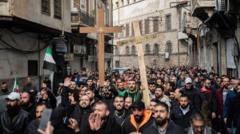The incident drew the attention of the Hayat Tahrir al-Sham (HTS), the dominant Islamist faction responsible for the uprising against the Assad government. HTS contended that foreign fighters were involved in the tree burning and pledged to safeguard the rights and freedoms of all ethnic and religious minorities in Syria.
Viral footage captured masked individuals pouring a substance on the Christmas tree, actions that left the community alarmed and questioning their place in a society undergoing rapid change. In the days that followed, protests swept through various districts in Damascus, where demonstrators voiced their discontent with the foreign fighters, calling for their departure and demanding the right to practice their faith openly. "If we're not allowed to live our Christian faith in our country... then we don't belong here anymore," lamented participant Georges, reflecting a deep-seated fear among minorities.
The protests have become a rallying point for various ethnic communities, highlighting Syria's diverse social fabric that includes Kurds, Armenians, Assyrians, Druze, and Alawite Shia, among others. As displaced Syrians begin to return to their homes, questions abound about how HTS will manage this new landscape, given its historical jihadist with a stated intention of forging a nation governed by Islamic law.
In an attempt to consolidate power, HTS announced plans to integrate different rebel factions under a newly formed Ministry of Defence. However, the vagueness of this initiative raises concerns about which groups will be included and how this merger will affect ongoing security issues.
Despite its designation as a terrorist organization by key international entities, HTS is reportedly pursuing a more diplomatic approach, evidenced by the recent removal of a bounty on its leader, Ahmed al-Sharaa, by the U.S. Despite military operations against the Islamic State group continuing in the region, HTS’s response to domestic dissent and its commitment to minority rights remains to be seen amidst the remaining complexities of Syria's volatile environment.
Viral footage captured masked individuals pouring a substance on the Christmas tree, actions that left the community alarmed and questioning their place in a society undergoing rapid change. In the days that followed, protests swept through various districts in Damascus, where demonstrators voiced their discontent with the foreign fighters, calling for their departure and demanding the right to practice their faith openly. "If we're not allowed to live our Christian faith in our country... then we don't belong here anymore," lamented participant Georges, reflecting a deep-seated fear among minorities.
The protests have become a rallying point for various ethnic communities, highlighting Syria's diverse social fabric that includes Kurds, Armenians, Assyrians, Druze, and Alawite Shia, among others. As displaced Syrians begin to return to their homes, questions abound about how HTS will manage this new landscape, given its historical jihadist with a stated intention of forging a nation governed by Islamic law.
In an attempt to consolidate power, HTS announced plans to integrate different rebel factions under a newly formed Ministry of Defence. However, the vagueness of this initiative raises concerns about which groups will be included and how this merger will affect ongoing security issues.
Despite its designation as a terrorist organization by key international entities, HTS is reportedly pursuing a more diplomatic approach, evidenced by the recent removal of a bounty on its leader, Ahmed al-Sharaa, by the U.S. Despite military operations against the Islamic State group continuing in the region, HTS’s response to domestic dissent and its commitment to minority rights remains to be seen amidst the remaining complexities of Syria's volatile environment.




















